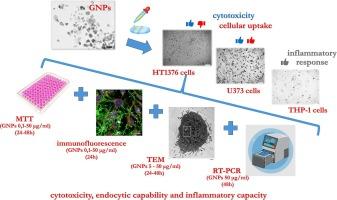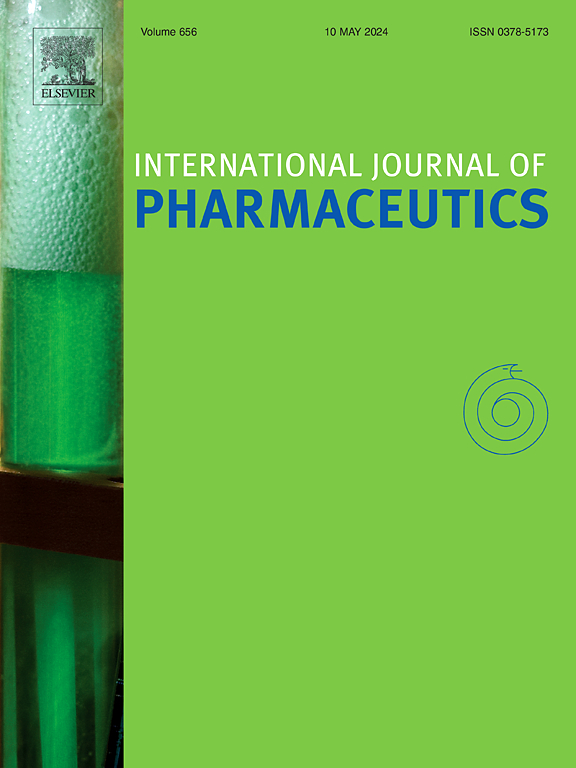用于生物医学应用的定制石墨烯纳米颗粒:模型细胞系功能的初步体外表征。
IF 5.3
2区 医学
Q1 PHARMACOLOGY & PHARMACY
引用次数: 0
摘要
通过对高纯度石墨进行环保型物理处理,可以很好地控制石墨烯纳米粒子(GNPs)的结构,生产出稳定且可重复的 GNPs 水分散体。制备方案包括对合成石墨进行球磨,然后在水中进行超声处理和离心/分离程序。这样,就获得了两种结构特征略有不同的 GNPs 样品:TOP60 石墨烯层的平均横向尺寸为 70 纳米,平均叠层数为 4;BOTTOM60 石墨烯层的平均横向尺寸为 120 纳米,平均叠层数为 6。对 GNPs 进行详细的结构表征是建立可靠的结构/性能相关性的必要前提,即生物医学功效和毒性方面的相关性,目的是合理设计用于生物环境的定制材料。为此,本研究通过测试 GNPs 在不同细胞系中的作用,对其细胞毒性、细胞吸收和炎症反应进行了全面鉴定。BOTTOM60 GNPs 在培养基中和细胞存在的情况下容易形成大的聚集体,这可能是它们在高浓度下具有细胞毒性的原因。另一方面,TOP60 GNPs 表现出不同的行为,这取决于所研究的细胞类型。事实上,具有内吞/吞噬功能的细胞(如星形细胞瘤细胞)能将纳米粒子内化,但上皮源性癌细胞却不能。此外,TOP60 GNPs 只有在高浓度时才会导致增殖减少,并且不会引发 THP-1 衍生巨噬细胞的炎症反应。本文收集的证据为进一步研究开发基于 GNPs 的药物输送系统铺平了道路。本文章由计算机程序翻译,如有差异,请以英文原文为准。

Tailored graphene nanoparticles for biomedical application: preliminary in vitro characterization of the functionality in model cell lines
Thanks to an environmentally friendly physical treatment of high purity graphite, a good control of the structure of graphene nanoparticles (GNPs) has been obtained with the production of stable and reproducible GNPs water dispersions. The preparation protocol entailed ball-milling of synthetic graphite followed by sonication in water and centrifugation/separation procedures. This way, two different GNPs samples with slightly different structural characteristics were harvested: TOP60, showing an average lateral size of the graphene layers <L> = 70 nm and average number of stacked layers <N> = 4, and BOTTOM60, with <L> = 120 nm and <N> = 6. A detailed structural characterization of GNPs was performed as mandatory pre-requisite to build reliable structure/properties correlations, in terms of both biomedical efficacy and toxicity, aiming at a rationale design of tailored materials for applications in biological environments.
To this end, in this study GNPs were thoroughly characterized, focusing on cytotoxicity, cellular uptake, and inflammatory response, by testing their effect in different cell lines. BOTTOM60 GNPs in culture medium and in the presence of cells showed a tendency to form big aggregates, phenomenon that was probably responsible for their cytotoxicity at high concentrations. On the other hand, TOP60 GNPs showed a diverse behavior depending on the cell type under investigation. Indeed, the nanoparticles were internalized by cells specialized in endo/phagocytosis, such as astrocytoma cells, but not by carcinoma cells of epithelial origin. Moreover, TOP60 GNPs caused a reduction of proliferation only at high concentration and did not trigger an inflammatory response in THP-1-derived macrophages.
The evidence here collected paves the way for further investigations towards the development of GNPs-based drug delivery systems.
求助全文
通过发布文献求助,成功后即可免费获取论文全文。
去求助
来源期刊
CiteScore
10.70
自引率
8.60%
发文量
951
审稿时长
72 days
期刊介绍:
The International Journal of Pharmaceutics is the third most cited journal in the "Pharmacy & Pharmacology" category out of 366 journals, being the true home for pharmaceutical scientists concerned with the physical, chemical and biological properties of devices and delivery systems for drugs, vaccines and biologicals, including their design, manufacture and evaluation. This includes evaluation of the properties of drugs, excipients such as surfactants and polymers and novel materials. The journal has special sections on pharmaceutical nanotechnology and personalized medicines, and publishes research papers, reviews, commentaries and letters to the editor as well as special issues.

 求助内容:
求助内容: 应助结果提醒方式:
应助结果提醒方式:


